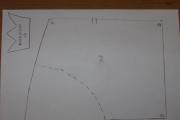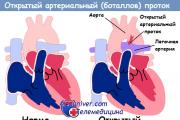What does a fetus look like at 20 weeks? Possible physical sensations
Week 20 – the conditional equator of pregnancy. At this stage, many mothers feel fetal movements for the first time, which further stimulates them to communicate with their baby. If there are no movements, you should inform the doctor about this and go for a test, which according to the plan should be done at 20-22 weeks.
Baby at 20 weeks of pregnancy
In 20 weeks, the baby gained 250-300 g and grew to 17-18 cm. These figures are approximate as each fetus develops individually. The baby's growth rate and weight gain are largely influenced by the mother's lifestyle, nutrition and health status, as well as genetic factors (short parents, as a rule, give birth to small children and vice versa).
At week 20, the fetus is almost fully formed, but outside the uterus it is not yet viable. If we analyze everything that happened to the baby over last weeks, we can highlight several of the most important points:

Mother's feelings at 20 weeks of pregnancy
The most important feeling of the 20th week of pregnancy is the baby’s first movements.. The fetus, of course, has been moving for a long time, but its size and force of movement were not sufficient for the mother to feel them. Now the baby is stronger and more active, so every day the strength and number of “kicks” will increase, but it is still too early to judge the baby’s condition based on them. But from the 28th week of pregnancy, the gynecologist will even advise keeping a special record of monitoring the activity of the fetus.
For what reasons may the baby’s movements not be felt at the 20th week of pregnancy? There are several such reasons:
- Excess weight of the expectant mother.
- Small size of the fetus and incorrectly calculated period.
- Polyhydramnios.
- Low motor activity crumbs.
- Banal inattention (some women confuse the baby’s movements with increased intestinal motility).
 From the 20th week of pregnancy, many expectant mothers begin to feel so-called training contractions. They are short-term contractions of the uterus (the abdomen seems to turn to stone for a moment), which do not lead to the onset of labor activity. The main difference between such contractions and real labor is the absence of pain and an increase in the duration of uterine contractions.
From the 20th week of pregnancy, many expectant mothers begin to feel so-called training contractions. They are short-term contractions of the uterus (the abdomen seems to turn to stone for a moment), which do not lead to the onset of labor activity. The main difference between such contractions and real labor is the absence of pain and an increase in the duration of uterine contractions.
If we talk about a woman’s well-being at 20 weeks, it remains consistently normal. From time to time, the expectant mother may be tormented by problems with stool, may, may, may bother, may appear when walking, may occur after a long stay on her feet. All these conditions should not bring severe discomfort to the pregnant woman, but if they do (for example, swelling does not go away after rest, it constantly bothers headache), you should definitely consult a doctor.
The average weight gain of a woman in the 20th week is 400-500 g, the permissible total gain for the entire period is 3.5-5 kg. The expectant mother must understand that there is still half of the pregnancy ahead, so too rapid weight gain may result in the weight increasing by 20 or more by the time of childbirth, not by the recommended 10-12 kg.
Possible complications
Expectant mothers need to monitor the nature of vaginal discharge. You should consult a doctor if:

Another possible complication at week 20 is isthmic-cervical insufficiency(abbr. ICN). Normally, the entrance to the uterus is tightly closed until birth. With ICI, due to the inability to cope with the increasing load, the dilation of the cervix occurs prematurely. Gynecologists distinguish two variants of the pathology in question:
- Traumatic(associated with damage to the muscle ring of the cervix during previous births and intrauterine interventions).
- Functional(caused by hormonal disorders– excess androgens and). This type most often occurs between 16 and 27 weeks.
ICI can be asymptomatic; it is often discovered when gynecological examination or ultrasound. In some cases, a woman may feel pain in lower sections belly. To maintain pregnancy, patients diagnosed with ICI are prescribed hormonal drugs, impose obstetric pessary(a special ring that prevents the dilation of the cervix) or surgical treatment.
Ultrasound and tests: norms at 20 weeks
An ultrasound at 20-24 weeks gives the doctor the following information:

Pregnant women should approach issues of caring for their face, body and hair with special responsibility. This need is due to the possibility of various cosmetic problems, allergies to care products, as well as exacerbation of dermatological diseases, etc.
To stay beautiful and healthy, expectant mothers should:
- Take a shower every day (now is not a good time for hot baths).
- Use for intimate hygiene by special means(they do not dry out the mucous membranes, do not change the pH, do not provoke the development of dysbiosis, etc.).
- Apply to the body cosmetic oils and lotions that prevent the appearance of stretch marks.
- Avoid direct contact with face sun rays and apply sunscreens in summer (this will reduce the likelihood of age spots appearing).
- Avoid using depilatory creams, chemical peels, ammonia paints for hair and other aggressive chemicals.
- Do not experiment with new creams and decorative cosmetics. During pregnancy, it is impossible to predict what the skin's reaction to them will be.
- Use rubber gloves when working around the house. This will help protect your legs, which are already very brittle.
Nutrition also plays an important role in maintaining health and beauty. For expectant mothers, this point is doubly important, since the condition of the baby depends on what and in what quantities the mother eats. Pregnant women need to structure their diet in such a way as to fully provide the body with proteins, healthy fats, vitamins, fiber, iron, calcium, magnesium, potassium, phosphorus, iodine. Food must be tasty, varied and necessarily safe (no raw meat, sushi and unusual exotic delicacies). If proper diet does not help to cope with the deficiency of certain substances, you should not refuse the vitamin and mineral complexes prescribed by the gynecologist.
At the 20th obstetric week of pregnancy People around her pay attention to the rounded waist of the expectant mother in labor and notice how beautiful she looks. The middle of the term gives you the opportunity to feel the movements of your baby under your heart and experience the wonderful experience of the first knock of your foot.
Almost five months have passed since the joyful news about the future addition to the family, and during this period of time mother and child managed to feel a whole series changes, let's look at which ones.
Fetal size and development at 20 weeks of gestation
Fetal height and weight
By this week of pregnancy, the baby has grown to size large fruit fruit, like coconut or papaya.
Weight the fetus at the 20th week of pregnancy approached the mark of 270 grams, and height: from head to tailbone varies between 14 and 17 cm, from head to heels - within 25 cm (about the length of an average banana).
If before the fifth month it was possible to determine only the height from the top of the head to the tailbone of the baby, due to the fact that the legs were in a bent position, now the standards of an adult are applicable to it - from the head to the soles of the feet.
Organ formation and baby behavior
During the twentieth week of pregnancy, signs of hair appear on the body (lungo fluff in place of eyelashes and eyebrows) and nails on the baby’s tiny fingers. The child begins to show more activity, he spins in the womb, makes grasping movements with his arms, wraps the umbilical cord around them, pushes with his legs, does somersaults in his mother’s stomach, pulls his finger into his mouth and even yawns.
 Appears baby's first reaction to light, he closes his eyes when the rays hit them. The baby's sebaceous glands produce a special secretion that protects the baby's vulnerable skin while he swims in amniotic fluid.
Appears baby's first reaction to light, he closes his eyes when the rays hit them. The baby's sebaceous glands produce a special secretion that protects the baby's vulnerable skin while he swims in amniotic fluid.
The organs in the baby’s body change, two weeks after the equator of the pregnancy period, the lungs become first attempts to breathe. The doctor can now clearly listen to the baby's heartbeat. An organ that produces blood appears in the body - the spleen.
The intestines continue to actively develop and show signs of the first excretion of feces (meconium resembles dark glue). The baby makes swallowing movements more and more often, which contributes to the development of his digestive tract.
Twins at 20 weeks pregnant
The development of twins and even triplets occurs in exactly the same way as a single fetus. But there is some difference - mothers who will become the happy owners of double happiness have a slightly larger belly than those who are carrying one child, and the children’s weight is slightly less. When listening to the heartbeat, you can immediately distinguish two rhythms that beat in unison.
What happens to mom at 20 weeks

First of all, the uterus changes, it moves a little higher and increases in size. Myself the tummy becomes more noticeable, rounder, the navel protrudes forward on it. There is a danger of stretch marks appearing during this period. by an average of 3-4 kilograms, and should continue to grow by about 300 grams per week. You can see photos of bellies at 20 weeks of pregnancy above.
The breasts may swell and secrete a translucent yellowish substance - colostrum. It is not recommended to squeeze it, just blot the nipples paper towel. This colostrum is the first workout female body before producing full-fledged milk for the baby. about him...
What sensations accompany the expectant mother?
- There is a possibility of discomfort in the lumbar and back areas. Don't worry, growing belly puts more stress on the whole body and sometimes it causes pain, but this is a natural process.
- There may also be leg cramps– a consequence of increasing pressure on the limbs.
- Pain in the abdomen- a warning sign! If you feel something like this, and especially if it appears from the vagina, be sure to contact your doctor.
- Can make you feel hot, especially at night, this is accompanied by sweating. Hot waves are the result of hormonal shocks that the mother's body experiences during pregnancy.
- Possible in some cases snore– here, too, there was the participation of hormones that affect the nasopharynx during sleep.
- Are increasing vaginal discharge at 20 weeks of pregnancy - leukorrhea. Just as in cases with colostrum from the breast, this is an absolutely normal process and is in no way associated with infections or disease. As a rule, they are white or yellow, with a thick consistency. This process side effect from increased blood supply to the uterus. about discharge...
- Happening frequency changes heart rate (increases by 8 - 12 beats per minute), pressure decreases (systolic by: 4 - 6 mmHg, diastolic by: 8 - 15 mmHg, pulse by: 6 - 10 mmHg. Art.).
- The most pleasant feeling is baby's movements at 20 weeks of pregnancy. It is at this stage that he first pushes and exhibits motor activity.
Emotionally, it is important to remain in a cheerful and upbeat mood!
Tests, examinations and ultrasound at the 20th week of pregnancy

From the very first day, pregnancy should proceed under the supervision of a doctor! Analyzes in the first and second trimester are carried out once a month in mandatory, and after the 20th week already twice in 30 days.
At 16-20 weeks of pregnancy, they are carried out to identify the development of congenital malformations (CHD), for this purpose blood is taken for alpha-fetoprotein and human chorionic gonadotropin. Both enzymes are serum proteins and their elevated levels in the blood may be an alarming signal about the beginning of the development of a chromosomal disease in the baby. This analysis is indicative only within a period of 16–20 weeks; earlier or later its results do not constitute evidence of disease.
Also, you will need to submit urine and blood tests to control blood sugar levels.
According to the plan, it is necessary to do it in the 20-22nd week. With its help, the condition of the placenta is not only established, but also analyzed, amniotic fluid, deviations are traced, etc. Using ultrasound, the doctor determines how well the child meets the parameters prescribed for his age, observes the functioning of the internal organs, and carefully examines the baby’s heart for the development of pathologies.
On this mother's ultrasound often come with dads to find out the gender together and look at the unborn child, look into the baby’s face and watch his first movements. We invite you to watch a video of an ultrasound of the fetus at 20 weeks of pregnancy, and above you can see the photo.
Possible deviations from the norm, threat of miscarriage
Unfortunately, there is always a risk of problems during pregnancy, as well. Test results may indicate three common complications accompanying fetal ripening.
Mom's diet and exercises at 20 weeks of pregnancy
Mom's nutrition
In general, the nutritional system at week 20 remains the same. All components of healthy food must be present: balance, sufficient volume, freshness and quality of products. It is important to use products intended for pregnant women . It is advisable to use the system fractional meals– eat little, but often. The following must find their place in the list of mandatory products: vegetables, fruits, cereals, milk.
Physical activity
 Classes, especially fresh air, not only will not harm expectant mothers, but, on the contrary, will strengthen their health. Especially useful for pregnant women yoga for pregnant women, Pilates, gymnastics, light aerobics.
Classes, especially fresh air, not only will not harm expectant mothers, but, on the contrary, will strengthen their health. Especially useful for pregnant women yoga for pregnant women, Pilates, gymnastics, light aerobics.
You are preparing him for future births, helping the baby to develop quickly, and helping yourself not to lose attractiveness.
Classes will help relieve tension in the legs and lower back, stretch muscles to prevent cramps, improve sleep and mood. However, it is necessary monitor your well-being during training and avoid overwork. It is advisable to consult with a specialist in this issue before starting classes.
Clothes and shoes
With today's rich assortment for pregnant women, it is not difficult to choose suitable outfit. The main thing is that the material was pleasant to the skin, didn't call allergic reactions and did not create unnecessary friction. Elastic, stretchy fabric will be optimal. Should be as comfortable as possible underwear, from natural fibers, not pinching the body.
Low-top shoes, convenient for walking, will make it easier for possible and future women in labor. IN cold weather opt for stable shoes and warm clothing.
Sexual relations at 20 weeks
 In the absence of any instructions from the doctor, then intimate life quite recommended. But it is important not to create excessive pressure on the abdomen and to create conditions suitable from a hygienic point of view for sexual intercourse.
In the absence of any instructions from the doctor, then intimate life quite recommended. But it is important not to create excessive pressure on the abdomen and to create conditions suitable from a hygienic point of view for sexual intercourse.
Hormones of happiness, received from, will bring pleasure not only to the mother, but will also delight the baby. But during sexual intercourse, if you feel discomfort, then this is a signal to stop the process.
- Despite the fact that in the middle of the term there may be a feeling that “I can move mountains” and the desire to do a lot of things at the same time, try not to get overtired.
- Be attentive to your body, if you find any of the warning signs described above, be sure to consult a doctor to prevent the development of complications.
- Create conditions for moral comfort; it is extremely important that you feel happy and enjoy every ray of sunshine. This is primarily beneficial for your child.
- Drink vitamins(after consulting with your doctor) and take calcium, it is essential for the formation of your baby’s bones.
- Observe healthy image life. A set of special exercises + healthy eating + good mood= feeling wonderful.
- Buy a bandage, supporting your growing tummy, it will serve you for several more months.
Video about the 20th week of pregnancy
We invite you to watch a video on questions that arise for expectant mothers in the 20th week of pregnancy. Experts give competent advice for mothers about traveling by car, using household appliances, choice suitable clothing, work schedule. Video - short excursion for those who want to hear short, succinct information about how best to behave in the prime of pregnancy.
The 20th week of pregnancy completes the first half of the baby's gestation period. Toxicosis has receded, the mother’s health and mood are high. It is at this time that many begin to feel the first movements of their little one. At this time, the woman can receive a referral for a second planned ultrasound. Next we will talk about the differences between ultrasound examination during this period and what are the developmental norms for a baby at 20 obstetric weeks.
What is it produced for?
At the end of the fifth month of pregnancy, an ultrasound is not just a whim for a woman who wants to admire her growing offspring. This test is part of second trimester screening. According to the recommendation of the Russian Ministry of Health, screening is carried out from 18 to 21 weeks. Most often, a visit to the ultrasound room falls precisely on the 20th week - the period between 19 and 20 weeks (by a woman’s standards, more than 17 weeks have passed since conception).


Screening includes studies of venous blood using a biochemical method using a triple or quadruple test. This study helps establish exceeding or underestimating the level of important for normal pregnancy hormones and proteins. Their changes often accompany various genetic pathologies. The picture is complemented by an examination in the office ultrasound diagnostics.
In the first trimester, from weeks 11 to 13, the woman had already undergone the first screening, and therefore the individual risks of giving birth to a baby with Edwards, Down, Turner syndrome and other incurable diseases of genetic origin are already known. The second screening makes it possible to judge such an unpleasant prospect on the basis of other substances in the blood, as well as other markers of pathologies on ultrasound.

In addition, ultrasound examination at this time may serve other purposes:
- assessment of child development;
- assessment of the condition of the placenta;
- diagnostics possible deviations during pregnancy - risk premature birth, fetal death;
- clarification of gestation dates and more precise definition due dates

Preparation for the procedure and features of the procedure
An ultrasound examination at week 20 is carried out externally, transabdominally, that is, the sensor is moved along the abdomen, the view is accessible through the wall of the belly.
There are not many situations in which a doctor can decide to use a vaginal sensor for ultrasound at this stage. Basically it's overweight a pregnant woman has significant fat deposits in the abdominal area.
If it is not possible to examine the baby with a sensor through the abdomen, a decision is made on a transvaginal ultrasound.
Internal ultrasound can also be performed if premature abnormal dilatation of the cervix, cervical insufficiency, or placenta previa is suspected.

At week 20, an ultrasound examination is not carried out in an examination chair; for this purpose, a couch is used, on which the expectant mother can sit either in a supine position or in a side position, if lying on her back is not comfortable.
Ultrasound does not require any special preparation at this time. No need to drink water, follow a diet, or rid the intestines of gases- the uterus is already so large that the intestines, along with the gases filling it, are pushed back, and do not interfere with the view.
When undergoing a screening ultrasound at 20 weeks, there is no need to donate blood on the same day as a visit to the diagnostician’s office; during this period, these components of perinatal diagnosis can be carried out in different days. The procedure lasts 5-10 minutes, it will not cause harm to the pregnant woman and her baby.
What will the ultrasound show?
During the first half of pregnancy, the baby has made a huge evolutionary journey. Almost all his organs are formed, the functioning of his systems is being improved - the nervous system, in particular. The baby's height this week is about 26 centimeters. The child weighs only about 300 grams.
This week the baby has a big event - his eyes acquire photoreceptors, and now the baby can distinguish between light and darkness. If you shine a flashlight on your belly, your baby's movements may increase. At the end of the fifth month, the baby learned to “make faces”, and now on an ultrasound, if you’re lucky, you can see how he squints, blinks, and grimaces.


The child looks like a small, but already fully formed, man. He already has excellent control over his arms, plays with the umbilical cord, and sucks his fists. His intestines are working, the baby swallows amniotic fluid, the small stomach began to function.
At week 20, the doctor carefully examines the fetus (or fetuses, if there are several of them in the uterus), assesses the size of the baby, compares the results with tables of normal for gestational age values. This allows you to install not only exact date, adjust the due date if necessary, but also understand Does the baby get enough nutrition, does he have any diseases? which may interfere with its normal development.


The doctor will be able to examine internal organs baby, assess the condition of the placenta, umbilical cord, amniotic fluid. If the mother’s health leaves much to be desired, a scan will allow her to be assessed. reproductive organs, identify inflammation, cysts, possible problems with the cervix and cervical canal, which may be signs of an impending miscarriage.
Ultrasound at 20 weeks The gender of the baby is clearly visible, there should be no problems with its definition. At the first ultrasound, it was difficult to accurately see the sexual characteristics because they were too small. In the third, which occurs at the end of pregnancy, gender diagnosis can also be difficult. The child will become large, “curl up” in a compact position, and it will be very difficult to see a boy or girl in the baby.
Now is the right time to find out who to expect - a son or a daughter.

Indicators, norm, interpretation
All standards are provided for informational purposes only and cannot be used as a basis for self-diagnosis of problems. A deviation from the average values does not always indicate a disease; doctors evaluate almost all parameters in proportion to each other.
In the ultrasound diagnostic protocol, the doctor notes the number of babies found in the uterus and always notes whether they are alive. A living fruit is considered to be such a fruit whose motor activity and heartbeat are recorded. At this time, the type of location of the baby in space must be indicated - cephalic presentation, pelvic or transverse.


If the doctor writes that the baby is in the pelvic or transverse position, don’t be scared or worried. During the day, the baby, who feels good and free in the uterine cavity, makes several dozen turns from head to toe and back.
If at the time of the mother’s diagnosis the doctor “found” him in a transverse position, this does not mean at all that the child will remain in this position until the birth. Presentation at 20 weeks is not a big deal.
In the “Fetometric Indicators” section of the protocol, the pregnant woman will find various letter abbreviations and numbers, which are not so easy to understand. At the twentieth week, the doctor measures the length of the bones, the circumference of the head, abdomen, the transverse and longitudinal dimensions of the head, as well as the cerebellum.
Fetometry norms at week 20 (summary table):
Bone length:
Based on fetometry data, the ultrasound scanner independently calculates the estimated weight of the fetus. For given period Typical values are from 200 to 350 grams. Girls often weigh less than boys, even if the pregnancy dates in both cases coincide within a day.
In the “Fetal Anatomy” section, the doctor describes the condition of the child’s internal organs. Reviewed and described lateral ventricles brain, facial bones, spine, eye sockets, heart, kidneys, stomach, intestines, lungs, gall and bladder. If the doctor does not see pronounced malformations of these organs, then opposite the name of this or that organ will be the Latin N, which means “normal”.
If pathologies are detected, and an ultrasound scan at this time allows one to see the underdevelopment of a particular organ or its absence, then the doctor describes the type of pathology opposite the name of the organ. So, opposite the line “Intestines” an entry may appear - “Atresia of the anus” or “Dilated loops”.


Any pathology of internal organs can theoretically be a marker of chromosomal disorders, therefore each specific situation must be considered separately. Several additional ultrasounds may be required invasive diagnostics(cordocentesis or amniocentesis) to determine whether the baby has chromosomal disorders.
After this, the doctors will decide how and when to treat a child if his disease is considered curable. If these are total syndromes, then the mother will be given a little time to think about the possibility of terminating the pregnancy by medical indications. The final decision remains with the pregnant woman and her family.


At the end of the examination, the doctor indicates characteristics of the placenta- how high is it located from internal pharynx, along which uterine wall the attachment occurred. More often " children's place» fastened by back wall. The normal degree of placental maturity for this period is 0. At this stage, it is often detected low placentation or placenta previa. The doctor evaluates the size of the cervix, the condition of the cervical canal and the presence or absence of uterine muscle tone.
Possible problems
BPR and LZR of the head are less than normal
A slight deviation from the average tabulated values of the baby’s head size does not indicate anything alarming. All children in mid-pregnancy grow at different rates, and no one excludes hereditary trait appearance - a small head. A deviation from the lower threshold of normal for 2 weeks is considered alarming (if the fetal BPD, for example, corresponds not to the twentieth, but to the eighteenth week of pregnancy).
Head shrinkage may be caused by microcephaly, as well as malnutrition. In this case, doctors will talk about intrauterine developmental delay of the baby. Additional research will help identify the exact cause; if development is delayed, the prognosis is favorable - they will help correct the situation vitamin preparations, and also medicines, which improve uteroplacental blood flow.

The baby's head is larger than the age norm
Excess normal indicators the size of the fetal head this week is sometimes a sign of hydrocephalus, swelling due to infectious processes or developmental defects. A slight excess of the indicators (by less than 2 obstetric weeks) may indicate that during this pregnancy there is a tendency towards a large (about 4 kg) or gigantic (more than 5 kg) fetus.
Again, the doctor needs to look at mom and dad, maybe they have big heads- a family trait, and then no correction will be required.

The baby's abdominal circumference is less than the gestational norm
This indicator may be a feature of the child’s physique, because thin mothers and fathers usually give birth to equally slender children. As is the case with the size of the fetal head, a lag from the norm of more than 2 weeks is considered critical.
This situation requires a careful study of the uteroplacental blood flow, especially the placenta, in order to promptly identify possible causes of malnutrition. Thinness of the fetus in itself is not dangerous. The task of doctors is find her the real reason, which may pose a risk to the child's future development.

Bone length does not correspond to age
An indirect marker of genetic pathologies during the second ultrasound is the shortening of the shin bones; the length of the remaining bones is measured only in order to imagine the proportions of the baby, as well as to track its development.
Shorter or longer forearms or femurs in most cases turn out to be features of the child’s appearance, because he may have genetic long legs or short arms. Such changes are considered physiological.
At the 20th week of pregnancy, the little man under your heart will grow to about 14-16 cm and weigh about 0.26 kg. Its thin skin is differentiated into layers. You may still be waiting for your baby's first kick. Now you have every chance to forget about heartburn, but many other symptoms persist.
How many months?
The twentieth week is almost five lunar months. Why lunar? This way (based on the phases of the moon) is more convenient to calculate. 40 weeks = 10 lunar months or 280 days.
Middle in half
At this time, every expectant mother can be congratulated on the upcoming “equator”. How is this? It's simple - 20 obstetric weeks of pregnancy means that you have passed about half of your term.
Of course, this is all conditional. Some mothers give birth one or two weeks earlier than doctors expect. There are also those who carry their baby to term. Everything important and interesting about the timing and methods of calculation -.
Feeling like a future mother. Does it move or not?
According to medical standards, it is at 20 weeks that mothers who are expecting their first baby should feel his kicks. Do you still feel any movement? There are reasons for this:
- you have a rather large figure, and this reduces your sensitivity;
- polyhydramnios;
- incorrectly calculated period;
- small size of the fruit itself;
- low activity of the baby.
If you regularly visit a doctor, he will definitely listen to your baby’s heart. Besides, you had an ultrasound. There, your child was carefully examined and checked for pathologies. So there is no need to be afraid of the lack of shocks - nothing bad is happening! Just tell your doctor, he will monitor you and your baby more closely.
If your baby has already pleased you with his first kicks, don’t try to track how often he does this. For now, you feel only the most active movements of the baby. Doctors will judge the condition of the fetus by the number of movements at a later date.
Other sensations
You can experience another joy. This is the disappearance of heartburn. Your body is in once again adapts to changes in the position of internal organs. But for some mothers, heartburn may still persist. You can mark:
- slight swelling of the arms, legs and face, which goes away fairly quickly;
- changes in posture and gait;
- slight weakening of vision (especially if it was impaired before pregnancy);
- age spots on the face;
- problems falling asleep - even surrounded by pillows, you are not immune to discomfort;
- feeling of shortness of breath, shortness of breath when walking or climbing stairs.
- periodic constipation.
Weight gain
Now, at half term, it is considered normal if you have gained 3.5-4 kg since the beginning of pregnancy. This is the average data. They may vary slightly depending on how hard it was. early toxicosis(if there was one), on your current appetite and initial build.
Uterus and belly
The baby’s “house”, your uterus, is constantly growing, followed by your tummy becoming rounder. Have you noticed the first stretch marks? Buy special cream or use olive oil. Right now, your skin may not have enough elasticity to cope with rapid growth belly.
Are you pregnant with twins or triplets? The belly is larger and the load on the skin is higher.
Now and until the birth you can “get acquainted” with training contractions. Imagine: your entire stomach suddenly tenses for a few seconds, even as if it hardens. If this happens rarely and only for a short time, do not be afraid. And constant repetitions are already warning sign, be careful. Especially if the uterine tension is very painful.
Photos of bellies (click to enlarge)
What hurts there?
Do your lower back and stomach sometimes feel tight? Are you experiencing minor pain? These internal organs “give way” to the uterus, and the ligaments gradually stretch. Not only the lower back, but the entire back may hurt.
Note to moms!
Hello girls) I didn’t think that the problem of stretch marks would affect me too, and I’ll also write about it))) But there’s nowhere to go, so I’m writing here: How did I get rid of stretch marks after childbirth? I will be very glad if my method helps you too...
All these sensations are unpleasant, but tolerable. But if something really hurts, call a doctor. Miscarriage and fading of pregnancy are possible at any stage.
Discharge
Brown, bloody, yellow and strong-smelling mucous smears - bad symptoms. They require urgent medical care, because they signal inflammatory processes or even miscarriage.
If the discharge looks like water and noticeably dampens your underwear, it could be amniotic fluid leaking. Let the doctor antenatal clinic will examine you.
The norm is clear or white mucus without an unpleasant odor.
Placenta
This is a special organ through which your baby receives necessary nutrition and gets rid of decay products. The location of the placenta is very important. If this organ has formed close to the cervix, it can be dangerous. Do you have low lying placenta or placenta previa? Don't panic, but be careful. The antenatal clinic doctor will monitor you with increased attention.
And another difficulty - toxicosis
If you had early toxicosis, you have probably already forgotten it. But it also happens late toxicosis, aka gestosis. About it so as not to miss possible complications.
Fetal development
A real little person is growing inside you. He has almost the proportions of a newborn. The height is 14-16 cm, and the weight is about 260 g. The fetus spends almost the entire day at rest, and only moves for a few hours every day. The tiny brain sends signals, and your baby “tests his strength”:
- moves arms and legs;
- turns the whole body;
- moves his head;
- opens and closes mouth;
- sucks fingers (usually the big one “comes across”);
- sometimes grabs the umbilical cord;
- slightly inflates chest as if he was breathing.
On the Internet you can often find the statement that the fetus coordinates its movements, and all its games are conscious. This information is incorrect. The child will learn to control his muscles, long and gradually, over several months and even years after birth. But even now, every movement of the fetus is a natural miracle, albeit a reflex one.
A small heart pumps blood steadily. Constantly enters the baby's stomach small quantity liquids. It is processed into urine and excreted into amniotic sac. Amniotic fluid is regularly renewed, so that the baby is not in a toxic environment.
But the intestines are not yet working at full capacity. The particles that remain in it are collected in meconium, the original feces. He will be bred when the baby is born.
Another important process. Thin skin The baby begins to divide into layers.
Visits to doctors
If you have not previously been tested for hCG hormones, AFP and free estriol (to detect possible pathologies), the doctor will prescribe them this week. The same goes for ultrasound. With an ultrasound examination, in addition to the basic parameters of your baby, you can find out the gender of the unborn baby.
The ultrasound technician will perform a very thorough examination of the fetus. He will determine the overall dimensions, as well as the circumference of the head and the length of the arms and legs. The doctor will definitely compare them. In addition, all internal organs, the condition of the heart and major vessels, plus the location of the placenta will be checked.
The position of the baby in the uterus is not important yet. Before giving birth, he may roll over more than once.
Photo of ultrasound (clickable)
- Eat right: cereals, fruits and vegetables, meat, fish plus milk in different types. Do you want something “harmful”? You can afford it, but only rarely and in minimal quantities. And, of course, never indulge in alcohol or cigarettes!
- If you notice that you are suddenly feeling hungry, always carry something to snack with you. Just don’t go to cafes, canteens and various “eateries”, food poisoning you don't need anything!
- Buy simple scales if you do not have them, and monitor changes in body weight.
- If your doctor prescribes vitamins, follow the recommendations.
- Be careful in public transport, especially during rush hours.
- On the subway, bus, etc., do not hesitate to ask for a seat.
- Avoid sudden movements, jolts, slips and falls.
- Sexual life is at your request and for mutual pleasure. But there are also limitations: a small amount of amniotic fluid, pregnancy with more than one baby, the threat of miscarriage, low location of the placenta.
- Sign up for courses for a young mother (you can do it together with your dad, if he doesn’t mind).
- Take care of your feet. In the evenings, pour alternately warm and cool water up to your knees. This will strengthen blood vessels and increase the tone of small muscles.
- Talk to your baby.
- Do your family and friends want to touch your tummy or feel your baby kick? Allow it if it pleases you. Otherwise, refuse, just calmly.
- Avoid everyone strong emotions. Now you should not only be upset, but also wildly rejoice. This can make you very tired and cause loss of strength. Be cheerful and happy, without outbursts of different feelings.
- If pigment spots appear on your face, they cannot be hidden with cosmetics. Just add a distracting detail to your look - wear interesting brooch, a blouse with a patterned yoke, a pendant or beads. On weekdays - only if this is allowed by your employer's dress code.
- Do what you love. Let it be handicrafts, reading, playing a musical instrument. Just don't get too tired.
- If possible, always sleep during the day.
- Forget about what the world has high heels and platforms.
- Walk every day, but don't walk too much.
All expectant mothers are a miracle of nature, and you are no exception. Remember this every day.
Video guide: 20th week of pregnancy what is happening, fetal size, abdominal sensations, sleep patterns, driving
Note to moms!
Hello girls! Today I will tell you how I managed to get in shape, lose 20 kilograms, and finally get rid of terrible complexes fat people. I hope you find the information useful!
The 20th week of pregnancy is the fifth obstetric month. If you look at it by week, 134-140 days have passed since conception. The second part of pregnancy is easier to bear psychologically, since the baby is already clearly felt and the expectant mother has time to love him. The belly at 20 weeks of pregnancy becomes increasingly noticeable as the second trimester continues. The woman feels good and enjoys an interesting position.
Development and size of the fetus at 20 weeks of gestation
What happens to mother and baby at 20 weeks of pregnancy? The weight of the child (fetus) at the 20th week of pregnancy is 270-350 grams, and the size of the fetus is 24-26 cm. Until this time, due to the legs being in a bent position, measurements were taken only to the tailbone, but now adult standards are applicable to the fetus - height from head to toe.
Within a few weeks the baby will theoretically become viable. Almost all systems and organs are formed in the fetus, but for them full readiness It will take more time to work outside the womb.
The child can already distinguish sounds and light, he can turn his head and suck his finger. He mostly sleeps, but there are also periods of wakefulness. Skin The baby's breasts become denser, and fatty tissue appears underneath them. Only there is still no fat on the face, so it remains wrinkled.
The 20th week of pregnancy is also significant because at this time the baby opens his eyes for the first time, which have not only eyelids, but also eyelashes. He develops a reflex blink. Fetal movements at the 20th week of pregnancy are already clearly felt by the expectant mother. At this time, it is important to communicate with the baby; you can sing songs to him.
By the 20th week of pregnancy, many babies are in the correct intrauterine position - upside down. If this has not happened yet, then do not worry, since there is still plenty of time for a coup, and this may happen more than once.
Ultrasound and tests at 20 weeks of pregnancy
The 20th week of pregnancy is characterized by the fact that the doctor may prescribe a second planned and ultrasound examination. A pregnant woman also undergoes urine and blood tests. Often at 20 weeks of pregnancy, a woman is examined in a chair to check the condition of the cervix. After 20 weeks, a woman should visit her doctor more often - twice a month instead of once.
A blood test is taken to determine the amount of sugar in the blood, and a urine test will help find out about kidney function or the occurrence of hidden inflammation. Also the woman gives biochemical analysis blood, which is also called a triple test. It evaluates the level of the hormones estriol, hCG and alpha-fetoprotein. Their inconsistency normal value allows us to identify birth defects fetal development.
During an ultrasound at 20 weeks of pregnancy, the following is determined:
During an ultrasound, the doctor examines the following organs of the child: intestines, lungs, liver, kidneys, bladder, stomach and gallbladder. One of the most common intrauterine defects is a heart defect. The doctor also examines it carefully, and if any discrepancies are detected, he prescribes an ultrasound of the heart.
Ultrasound photo at 20 weeks of pregnancy

What does a baby look like at 20 weeks of pregnancy?
The 20th week of pregnancy is also characterized by the fact that the fetus takes on an increasingly larger shape. little man and becomes more attractive. His arms and legs are fully formed, and his tiny fingers have already developed marigolds. Lanugo, the first hair, appears on the head. The same fluff grows in the area of eyebrows and eyelashes. The baby’s facial expressions are also actively developing – he grimaces and opens his mouth.

The baby reacts well to light - when light rays hit his eyelids, his eyes open slightly. His skin becomes thicker and sebaceous glands begin to produce the so-called vernix lubrication, which is a white fatty substance. On at this stage it protects the fetus from the surrounding liquid environment, and during childbirth it helps the baby pass through the birth canal so that it is easier for him to be born.
The skin turns from translucent and smooth to red with folds. An ultrasound clearly shows the outline of the baby's head, forehead, nose, upper and lower jaws. The fetal ears enlarge and take on their final shape.
What does the belly look like at 20 weeks pregnant?

The 20th week of pregnancy promotes distinct sensations of the baby moving, but sometimes they can be very strong. Possible reason– lack of oxygen in the fetus. To eliminate it, you need to spend more time in the fresh air, and, if possible, do fitness and gymnastics for expectant mothers.
At 20 weeks of pregnancy, the fetus still has enough room inside mom's belly, so it actively moves and turns over. He already hiccups, jumps from sudden movements or sounds, and also pushes away from the walls of the uterus. All these movements are clearly felt by a pregnant woman.
The child is able to distinguish between external sounds and the sound of the mother’s body. He also distinguishes his mother's voice.
Due to the fact that the fetus at 20 weeks of gestation hears everything, to the expectant mother Sharp sounds should be avoided.
At the 20th week of pregnancy, the baby’s heart beats clearly, which can be heard with a regular stethoscope. A fully formed baby continues to grow rapidly. It has functioning nervous, respiratory, endocrine, digestive and hematopoietic systems. Grooves and convolutions form in the cerebral cortex. During this period, molars begin to form.
About maturation nervous system This is indicated by the baby's movements such as thumb sucking and grabbing his body parts and the umbilical cord. He even begins to yawn. The child’s lungs cannot yet provide him with oxygen; only after a couple of weeks will he begin to train breathing movements. Endocrine system regulates the constancy of the internal environment of the baby’s body and participates in the work of all its organs and systems.
The 20th week of pregnancy is characterized by the fact that the baby swallows amniotic fluid, which leads to the formation of meconium - the baby’s first stool, which passes after the birth of the child. These swallowing movements develop his digestive tract.
20 week of pregnancy. Well-being of the expectant mother
Mid-pregnancy is usually accompanied by excellent appetite, excellent health and an almost complete absence of pain. The expectant mother is happy that she is halfway through the journey and is in a positive mood.
A pregnant woman at 20 weeks of pregnancy may experience pain in the lumbar region. This is due to increased stress on muscles and ligaments, which shifts the center of gravity. To eliminate unpleasant sensations, you can do exercises for the spine and try to maintain correct posture. You can also start wearing a special bandage.
Another possible unpleasant occurrence at 20 weeks of pregnancy is cramps. They also occur due to weight gain, which puts more stress on the legs. To prevent them, you need to massage your calves and feet more often and try to reduce the load on your legs. You should eat more calcium-rich foods and drink enough water.
At the 20th week of pregnancy, the uterus is located higher and higher, the stomach is rounded, the waist line is smoothed out, and the navel begins to stick out. The pigmentation of the midline on the abdomen also increases.
Some pregnant women notice translucent discharge yellowish tint from the mammary glands. This is colostrum, which is the first stage of lactation. It can be produced from the breast in small quantities until the end of pregnancy. It cannot be squeezed out, only wiped with a soft cloth. To prevent your breasts from losing their aesthetic appearance after childbirth, you need to choose a comfortable bra model that will provide good support to your heavier mammary glands.
Due to the growing uterus, the skin on the abdomen also stretches. A woman may feel a slight itch, which can be relieved by using special cosmetics. These include various creams, oils or lotions against stretch marks. They should be used daily, applying in a circular motion on the skin of the abdomen, chest and thighs. You can replace this product with olive or almond oil.
In the second half of pregnancy, a woman begins to gain rapid weight. This is especially true for those who do not adhere to the rules healthy eating. It is necessary to reconsider your diet and replace sweets with vegetables and fruits. It is better to eat meat and fish boiled, and also do not forget about porridge and fermented milk products.
It is best for the expectant mother to eat frequently, but small quantities, excluding spicy, smoked and fatty ingredients. It is important to ensure that weight gain per week does not exceed 500 grams. Also, a pregnant woman should take vitamins and minerals prescribed by her doctor.














